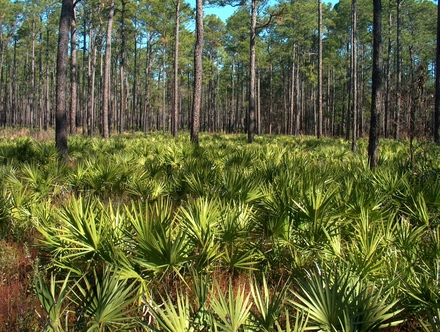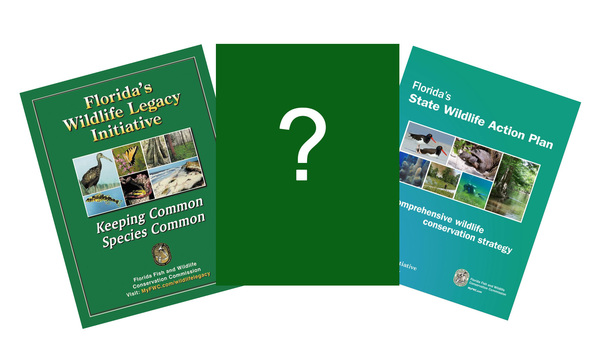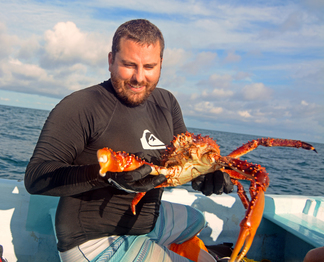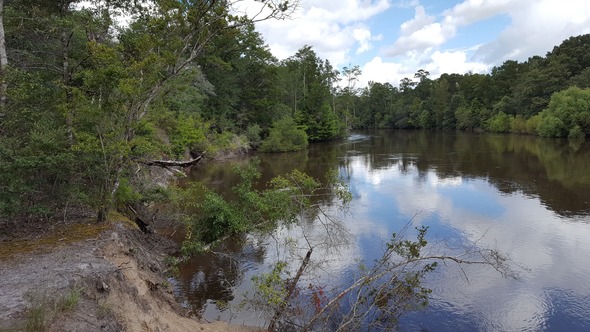Brian Branciforte
Leader, Florida's Wildlife Legacy Initiative
Back to top
A commonly made statement about Florida is that it is large and diverse. While our state’s human population now ranks third in the country, there remains remarkably high biodiversity and numerous rare, endemic and imperiled species – though the demographics and habitats vary widely from region to region. Moreover, Florida also has a large and diverse amount of information to work with – data and models ranging from soils and vegetation maps, to population growth through 2070, various climate change planning scenarios and species and habitat specific data. The conservation community in Florida has invested in generating an incredible amount of data, especially when compared with some states that do not even have an accurate map of their conservation lands!
 Left: Flatwoods are one of the many unique land cover types that make up Florida.
While this wealth of information brings great benefits, it also can be an obstacle. Vast amounts of information can lead to confusion or competition rather than collaboration. One such example is land cover classification systems used in Florida. There are numerous classification systems based on various combinations of different data such as natural plant and animal communities, existing land cover and land use. This has created issues, barriers and communication challenges when attempting to work with and across the different entities that use them.
This is an example of the importance of Florida’s Wildlife Legacy Initiative. FWLI worked with partners in the conservation community to address the need for a single land cover classification system that incorporates the level of detail and flexibility needed by the FWC and its conservation partners. This classification system is a hybridization of existing classifications and is flexible, extensible and scalable to allow for future changes and additions. It seeks to rectify the shortcomings of current habitat and land cover classification systems by creating a system that uses well-defined land cover classes unique to the state of Florida. But it also can be incorporated with systems in neighboring states, as well as regionally. Metaphorically, the new system is a Rosetta Stone that sets a common land cover standard, one that can aid with communications across all other similar models in use in the state.
With a state as large and diverse as Florida, our conservation paradigm requires us to find ways to optimize our resources and enrich partnerships more than ever. Florida’s Wildlife Legacy Initiative is working to provide such a forum for collaborative conservation on high priority issues.
|
Kevin Kemp
Communication and Partnerships Coordinator
Since the first staff were hired for Florida’s Wildlife Legacy Initiative in 2004, there have been a few changes and additions as the program gained momentum. But in 2017, we evaluated the talents and interests of current staff and decided to make some additional changes – changes we believe will move us into the new year better positioned to make even greater strides for conservation.
 Right: Caroline Gorga, Species and Habitat Monitoring Coordinator for Florida's Wildlife Legacy Initiative.
Two staff members, Caroline Gorga and Kevin Kemp, have a combined 18 years of experience working with the Wildlife Legacy Initiative. Their tenure and interests make them well suited to take on new roles that are greatly needed within the program.
Caroline, a Wildlife Legacy Biologist since 2012, has been promoted to the Species and Habitat Monitoring Coordinator. Monitoring is a critical component of the Wildlife Legacy Initiative, as we have a responsibility to determine whether and how the projects we fund have a lasting impact on fish and wildlife and the habitats they occupy. In fact, monitoring is one of the eight required elements of a State Wildlife Action Plan. Monitoring all of Florida’s habitats and species is a daunting task, and we readily admit we can’t do it all. So Caroline will continue working cooperatively with FWC’s species and habitat biologists to identify, prioritize and address monitoring needs and focus on increasing communication, coordination and collaboration to address these needs.
Caroline received her Master’s in Wildlife & Fisheries Biology from Clemson University, studying the ecology of the American mink in the coastal marshes of South Carolina. Prior to that, she received her B.S. in Biology from the University of North Carolina at Chapel Hill.
|
 Left: Kevin Kemp, Communication and Partnerships Coordinator for Florida's Wildlife Legacy Initiative
Kevin is one of the original Wildlife Legacy Biologists, first hired to write the State Wildlife Action Plan in 2004. In the years he has been with the program, Kevin has had several roles, with his newest one being the Communication and Partnerships Coordinator. Kevin relishes the opportunity to help people understand the importance of conserving our fish, wildlife and natural resources and working to create new and improved partnerships with stakeholders. Kevin received his B.S. in Wildlife from Purdue University. He also has experience in communication and marketing, co-owning Kemp Design Services, a graphic design and marketing company, with his wife Barbara.
Caroline and Kevin have already hit the ground running in their new roles, with Caroline authoring a new monitoring chapter in the next iteration of the State Wildlife Action Plan and Kevin working on communication strategies in support of the Recovering America’s Wildlife Act and the Alliance for America’s Fish and Wildlife. Caroline and Kevin can be reached at Caroline.Gorga@myFWC.com and Kevin.Kemp@myFWC.com.
|
Back to Top
Allie McCue
State Wildlife Action Plan Coordinator
One document, eight required elements, thousands of users and an infinite number of uses. Florida’s State Wildlife Action Plan is the chameleon of conservation planning for the Florida Fish and Wildlife Conservation Commission (FWC) and the state. Not only because of its seemingly slow-moving nature, but because of its ability to change based on the needs of its environment.
Will this single plan adequately function in many different capacities while maintaining its purpose and identity? Florida’s Wildlife Legacy Initiative hopes to answer this question with the introduction of the revised State Wildlife Action Plan in early 2018.
 Above: The 2005 and 2012 State Wildlife Action Plans were major efforts in fish and wildlife conservation. The 2018 plan is the next step forward.
A common theme some users may notice in the new plan is the balance between setting goals that are attainable with current resources and stretching to reach the broader vision of wildlife conservation in Florida. The plan clearly identifies short-term priorities while continuously tying those efforts back to long-term goals. Like a chameleon, the Action Plan can change its colors to match its environment by providing a wide range of information at various scales that can meet the needs of different users.
The development of the new Wildlife in Urban and Working Lands chapter is a great example of how the Action Plan is evolving with both the figurative and literal changing environment. This new chapter is designed to bring even more attention to the challenges and opportunities for conserving wildlife in significantly human-altered areas. Florida’s population has reached over 20 million and continues to grow. The expansion of urban areas will result in continued conversion of natural, agricultural and rural lands into other more intense land uses. While agriculture and timber production continue to be a vital commodity to the state’s economy and need to be sustained.
Additionally, urban and working landscapes provide essential habitat to many of Florida’s Species of Greatest Conservation Need. Although many SGCN have adapted to various components in these environments, there remain challenges that must be overcome to ensure these species can survive. The 2018 Action Plan identifies many of these challenges and offers a series of opportunities that could help minimize each challenge and/or positively impact SGCN. Opportunities consist of working with programs or initiatives already ongoing within and outside of the FWC. This chapter provides information on a variety of resources available to our partners, stakeholders and the general public and will be available once the Action Plan is completed in spring 2018.
In its short life thus far, the Action Plan has undergone two revisions. However, the word “revision” does not adequately give credit to the work that has been put into this process by FWLI staff and partners. A revision is typically associated with reviewing, modifying or adjusting a document. Whereas, the 2018 Action Plan has truly been a complete overhaul of the previous versions and will provide a step forward toward better conservation of Florida’s wildlife and natural resources.
For questions regarding the 2018 State Wildlife Action Plan, contact Allie McCue at Allie.McCue@MyFWC.com
Back to Top
Dan O'Malley
Wildlife Legacy Biologist
Coral reefs in seas throughout the world but especially in the Caribbean have become degraded by a variety of factors such as poor water quality, overfishing, vessel and recreational impacts, disease, increased sea surface temperatures, ocean acidification and sea level rise. In Caribbean waters, these negative impacts were exacerbated by the decline of important grazers on the reefs, such as the long-spined sea urchin (Diadema antillarum) and various species of parrotfish, which keep algae growth at suitable levels.

Left: Ph.D. student Jason Spadaro with a spider crab. Photo credit: Scott Jones (Smithsonian Marine Station, Ft. Pierce
The multitude of factors threatening
coral reefs may have led to what is referred to as an "alternate stable
state." This occurs when an ecological community has been so altered that
even if the factors responsible for the degradation are completely ameliorated,
the community will not return to its previous state without intervention. In
the case of coral reefs, macroalgae has become much more dominant in the system
than it was historically. Macroalgae has many negative effects on corals. They
overgrow corals, thereby cutting off their supply of light, occupy reef
substrate that otherwise would be bare and suitable for the settlement of
larval corals and produce chemicals deleterious to corals. A decline of
herbivores on reefs contributes to the threat posed by macroalgae, and even
where herbivores are present they may not be able to effectively regulate
macroalgae. That’s because many macroalgal species are chemically defended and
their tissues are infused with rocky calcium carbonate to discourage herbivory.
Furthermore, most grazing fish species strongly prefer turf algae and the sea
urchin Diadema populations which can
regulate macroalgae remain below historical levels.
The threat posed by macroalgae has
been long recognized, and several management actions have been developed to
address it. To date, the two primary actions are reintroducing Diadema to reefs, or restricting fishing
over reefs to recover the reef fish community and protect herbivorous fishes.
However, Dr. Mark Butler of Old Dominion University and his Ph.D. student Jason
Spadaro recently began work on a promising new method of regulating macroalgae
on coral reefs by increasing the density of spider crabs, Maguimithrax spinosissimus, on the reefs. Their preliminary work documented a high rate of herbivory by
this species, including herbivory on Halimeda,
a genus composed of several species of algae that are strongly defended both
physically and chemically and generally avoided by herbivorous fishes.
|
 Right: Spider crab. Photo Credit: Dr. Antonio Baeza, Clemson University.
In preliminary experiments, the spider crabs released on coral patch reefs remained on the reef and contributed to an over 80 percent reduction in the algae cover on these experimental reefs. In an experimental treatment where the algae were removed and crabs were added, algal cover was maintained at less than 15 percent for more than a year. Additionally, coral reproduction which is a major limiting factor in coral reef restoration, was increased by as much as three times at sites where crabs were added.
Florida’s Wildlife Legacy Initiative is excited to have awarded a State Wildlife Grant to Dr. Butler and his partners that allows him to continue this promising work. In a project that started in 2017, Dr. Butler will test the effects of spider crabs on coral reefs recently stocked with them, tracking the impact of the crabs on both the algal cover and the coral reefs’ growth, survival, disease and recruitment. Additionally, the effect on the fish community will be examined, with the hope that turf-grazing reef fishes will be more abundant on the coral reefs stocked with these crabs.
This work will be relevant to other ongoing State Wildlife Grant projects that are investigating the interaction of algae and other competitors with slow-growing coral species that have been stocked. To date, most coral restoration has been done with fast-growing Acroporid corals, but true restoration will require effective methods for a diverse suite of coral species, including those that are slow growing and therefore especially threatened by competition from macroalgae.
We look forward to seeing the results of this study and the development of another tool to rebuild Florida’s coral reefs and the Species of Greatest Conservation Need such as Nassau grouper and green sea turtles that depend on them.
|
Back to Top
Kevin Kemp
Communication and Partnerships Coordinator
Permanent, adequate funding for the conservation of the full array of Florida’s fish and wildlife may soon be a reality. The Recovering America’s Wildlife Act was introduced in Congress on Dec. 15, 2017 by U.S. Representatives Jeff Fortenberry, R-NE, and Debbie Dingell, D-MI. The act creates a long-term sustainable funding source to conserve the nation’s fish and wildlife, dedicating $1.3 billion annually in existing revenue from development of energy and mineral resources on federal lands and waters to provide funding to state fish and wildlife agencies to fully implement state wildlife action plans.
Florida would receive about $49 million a year to conserve the state’s most vulnerable species and their habitats under the Recovering America’s Wildlife Act. The required state funding match would be about $16 million. This is a significant increase from the approximately $2.5 million a year in State Wildlife Grants that Florida currently receives to support its State Wildlife Action Plan, which is used to proactively conserve species of greatest conservation need.
Conservation of our precious natural resources is critical to Florida, with fishing, wildlife viewing, boating, hunting and the seafood industry having a combined economic impact of about $42.8 billion and over 347,000 jobs. Florida also hosts over 100 million visitors a year, with many of them here to explore and enjoy the beauty of Florida’s wildlife and outdoors.
Back to Top
Thomas Kuhn
Wildlife Legacy Biologist
Florida’s Wildlife Legacy Initiative projects funded with State Wildlife Grant funds are tremendously diverse. Some projects restore native fish and wildlife habitat. Others improve the adaptability of an ecological system to future conditions. Still other projects seek to provide a better understanding of the biology of a species or the framework for future habitat restoration efforts by the FWLI and others. The latter projects often require patience, as is the case with the Yellow River Project that began eight years ago and finally is showing tangible results. It also appears to be producing a restoration value far beyond its initial anticipated investment.
In this case, the river project is addressing erosion and the resulting sedimentation, which pose a major threat to many of Florida’s waterways and the fish and wildlife there. Sedimentation can cover up woody debris, gravel bottoms and other substrates used by fish and wildlife for foraging, breeding and shelter. Murky water due to increased turbidity can be harmful to aquatic organisms. Stabilizing Florida’s eroding river banks, as well as paving roads as they approach bridges crossing the rivers, is an important step in restoring our waterways.
 Above: This bank of the Yellow River is a high priority site in need of restoration and stabilization to benefit fish and wildlife.
In 2009, FWLI commissioned a report, “Inventory and Prioritization of Impaired Sites in the Yellow River Watershed in Alabama and Florida,” in partnership with The Nature Conservancy and the U.S. Fish and Wildlife Service. The report contains a prioritized listing of erosive stream banks and road crossings throughout the Yellow River watershed, along with a list of the threats contributing to erosion. Where erosion threats were concentrated, they were grouped into “focal areas.” It is believed that addressing these areas will have the greatest impact at the lowest cost. The report is meant to encourage groups to use it for project identification and selection, potentially stimulating river restoration work of greater value than the initial investment.
The focal area with the highest concentration of threats is the lower Yellow River in northwest Florida. Several efforts are underway to improve water quality here. These efforts also benefit Eglin Air Force Base, located within this focal area that had multiple impaired river sites and road crossings. To restore the river and support the activities of the 7th Special Forces unit on Eglin AFB, eight unpaved and erosive road crossings have been replaced with paved bridges. The planned replacement of four priority crossings mentioned in the report with arch culverts also will be a substantial improvement over current structures. Meanwhile, stabilization and restoration projects for several erosive river bank sites in this focal area are in the early planning stages.
Elsewhere in the Yellow River basin, Okaloosa County recently committed $500,000 a year from their county’s RESTORE funds. The funds, resulting from civil penalties imposed after the Deepwater Horizon oil spill, will pave road crossings over the river for five years. The report is being used to help guide project prioritization. Other annual financial commitments to water quality in the focal area include $500,000 for stormwater improvements and $250,000 in matching funds for estuary improvements.
Reports similar to the Yellow River report have been commissioned for most of the major Florida panhandle watersheds by the Florida Department of Environmental Protection and Northwest Water Management District based on the success and planning value of the Yellow River Watershed report.
Ultimately, the Yellow River restoration continues to promote conservation of Florida’s fish and wildlife beyond its initial investment, and this project was made possible through the use of State Wildlife Grant funding in cooperation with our valued partners.
This bank of the Yellow River is a high priority site in need of restoration and stabilization to benefit fish and wildlife.
Back to Top
|